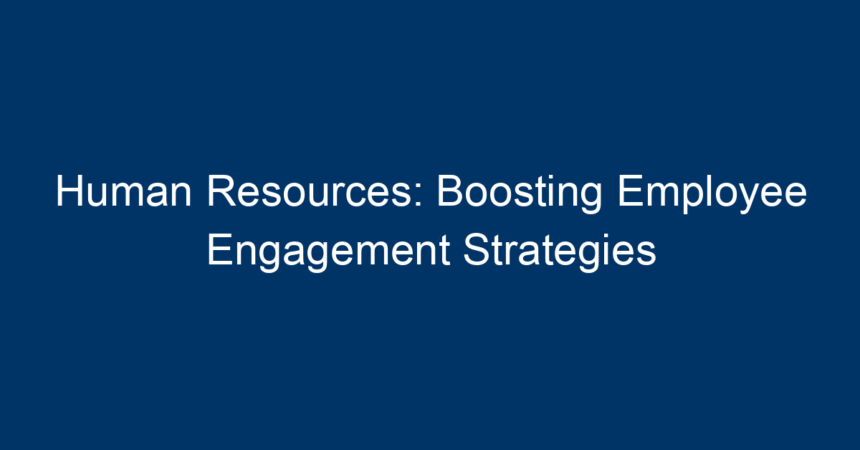Introduction
In today’s competitive business landscape, effective human resources management is not just about hiring and firing. A crucial element that has emerged as a cornerstone of successful organizations is employee engagement. Engaged employees are not only more productive but also more inclined to remain with their company, thereby reducing turnover rates and fostering a positive work environment. In this article, we will explore various strategies that human resources professionals can adopt to boost employee engagement, creating a culture of enthusiasm, loyalty, and high performance.
Understanding Employee Engagement
Employee engagement can be defined as the emotional commitment that employees have towards their organization and its goals. When employees are engaged, they are more likely to invest their time, energy, and creativity into their work. According to research by Gallup, organizations with high employee engagement levels see 21% higher productivity and up to 59% lower turnover rates. It’s clear that fostering a highly engaged workforce is not just beneficial but essential.
Why Employee Engagement Matters
Understanding why employee engagement matters is pivotal for any organization looking to thrive. Here are a few key reasons:
- Enhanced Productivity: Engaged employees tend to work harder, leading to higher output quality and quantity.
- Lower Turnover Costs: High turnover can be costly. Engaged employees are less likely to leave, saving the company recruitment and training expenses.
- Improved Employee Morale: A culture that prioritizes engagement fosters happier and healthier work environments.
- Customer Satisfaction: Happy employees lead to satisfied customers. Organizations with engaged employees often experience better customer experiences.
Key Strategies for Boosting Employee Engagement
1. Foster Open Communication
One of the most vital components of effective human resources management is encouraging open lines of communication within the organization. When employees feel heard, they are more likely to be engaged. Here’s how you can foster a culture of openness:
- Regular Check-Ins: Schedule consistent one-on-one meetings where employees can share their thoughts, concerns, and ideas.
- Feedback Mechanisms: Implement robust feedback tools like employee surveys, suggestion boxes, or digital tools to gather insights.
2. Offer Professional Development Opportunities
Investing in employees’ professional growth is a powerful way to enhance engagement. When employees see that their employer is committed to their development, it creates a sense of loyalty. Consider the following:
- Training Programs: Offer training that caters to both hard and soft skills relevant to their roles.
- Mentorship Programs: Create a mentorship scheme where less experienced employees can gain insights from seasoned professionals.
3. Recognize and Reward Achievements
Recognition plays a significant role in employee engagement. Employees want their efforts to be acknowledged and appreciated. Implement the following strategies:
- Spot Bonuses: Provide spontaneous rewards for exceptional performance to motivate employees.
- Recognition Platforms: Utilize platforms where employees can publicly acknowledge their peers’ contributions.
4. Cultivate a Positive Work Environment
The physical and emotional work environment significantly impacts employee morale and engagement.
- Flexible Work Hours: Allow employees to choose their work hours or the option to work remotely to improve their work-life balance.
- Work Culture: Promote an inclusive and supportive culture that encourages collaboration and team bonding.
5. Align Individual Goals with Organizational Objectives
When employees understand how their work contributes to the overall success of the organization, they are likely to feel more invested in their roles.
- Goal Setting Sessions: Conduct goal-setting exercises that align individual aspirations with company objectives.
- Regular Reviews: Hold quarterly reviews to discuss progress towards these goals, making any necessary adjustments.
The Role of Technology in Employee Engagement
Advancements in technology have changed the dynamics of human resources management. Utilizing modern HR software can greatly enhance engagement efforts.
1. Employee Engagement Platforms
Many companies are now turning to specialized software designed for enhancing employee engagement. These platforms often include features such as:
- Surveys: Automate regular engagement surveys to collect feedback efficiently.
- Gamification: Introduce game-like elements to everyday work tasks, making them more enjoyable and engaging.
2. Communication Tools
Effective communication is key to fostering employee engagement. Tools such as Slack, Microsoft Teams, or even project management software like Trello can create a collaborative environment where employees feel included and informed.
Measuring Employee Engagement
Measuring the effectiveness of your engagement strategies is crucial. Implement the following methods to assess your progress:
- Employee Surveys: Conduct anonymous surveys regularly to gauge employee satisfaction and engagement.
- Analytics Tools: Use analytics tools to track progress and adjust strategies where necessary.
- Performance Metrics: Monitor key performance indicators such as turnover rates, productivity levels, and employee satisfaction scores.
Conclusion
Boosting employee engagement is not merely a task for human resources; it’s a cultural transformation that requires commitment and strategy. By fostering open communication, offering professional development, recognizing achievements, cultivating a positive work environment, aligning goals, leveraging technology, and measuring engagement, organizations can create a vibrant workplace where employees feel empowered and valued.
Actionable Insights
- Start Small: Introduce one or two engagement strategies and gradually build up as you measure their effectiveness.
- Involve Employees: Involve employees in the decision-making process regarding engagement initiatives to foster a sense of ownership.
- Be Consistent: Always be consistent in your efforts, as sporadic initiatives can lead to disengagement.
By prioritizing employee engagement through effective human resources strategies, organizations can create a thriving and resilient workforce ready to face challenges and drive sustainable growth.




